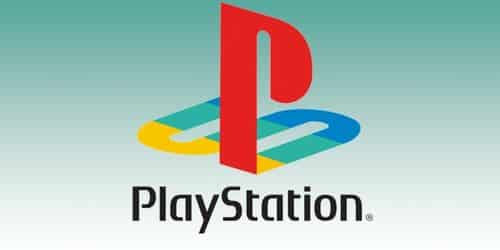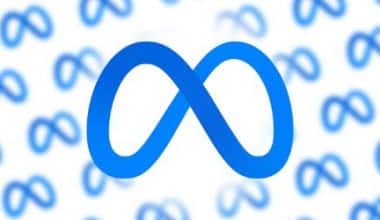PlayStation is a well-known brand that has made consoles, media centers, line controllers, and handheld devices for many generations. It came out in December 1994, at the same time as the first video game console, produced by Sony. Since the original PlayStation came out in 1994, Sony has produced three subsequent generations of the gaming system. When it comes to video game systems, the PlayStation is clearly the market leader. However, talking about the history and evolution of Playstation without its logo is just like talking about football without a trophy. PlayStation features a memorable logo that helps consumers keep the brand in mind. The original PlayStation logo, including its old colors and overall shape, has been revised multiple times despite the fact that the product is still relatively young.
Original Playstation Logo
As a result of the success of its game consoles and video games, the company is now a household name around the world. The distinctive logo is basically recognized all around the globe. Despite its relatively young, the logo has undergone multiple revisions and is available in a number of different iterations. From the old Playstation logo to the original and present racing track logo that enables users to join and enjoy the game.
The logo’s attempt to conquer the galaxy began in 1988 when Sony and Nintendo worked together on a game console. However, differences occurred between them regarding the project’s plans, and the firms decided to end the contract. After then, it took the Japanese company five years to build the gaming system on its own. As a result, it was released one year later than expected. The first and original Playstation logo was also shown off by her at the same time.
1994 – 2009
In 1994, the first logo was released based on an artistic rendering of the PlayStation abbreviation, “PS.” This solution was selected from a pool of roughly twenty that were submitted to the management. It was designed by the Japanese artist and designer Manabu Sakamoto, who also designed other iconic Sony logos (VIAO).
He suggested a three-dimensional logo with the letter “P” standing and the letter “S” lying as though it were the first letter’s shadow. The semi-ovals are also played in a unique way, utilizing the space left available above the letter “P.” The spherical pieces are all a different hue, making this an interesting take on the standard text-and-image-and-color layout.
There’s also a variant utilized by the PlayStation 3 system. A blue “S” lies almost horizontally, with yellow and red dots flanking its upper and lower extremities. In yet another iteration, the company reverted to the original brand colors while redesigning the logo.
Manabu Sakamoto also created a comprehensive collection of symbols, which the company can employ for any console generation. The “P” with the white letter “S” inside is also played in both of these renditions.
2009 – today
With its most recent redesign, the PlayStation logo features a black-and-white color scheme, making it the most pared-down version yet. It’s a timeless combination of black and white that never loses its classy demeanor. From the looks of the presentation, this is an exact replica of the prior version in terms of the proportion of geometric forms and visuals.
However, the names given to each console series individually are still in use. They have curving contour lines that resemble the letters “P” and “S,” and to the right of them is the console or video game’s serial number. The symbols are intertwined like a snake’s body.
PS4
The fourth generation of the Playstation system, which was released in November 2013, has a logo that is stylistically consistent with the overall idea of the company. A capital “PS” logo can be seen on the left, with one letter standing vertically and the other appearing to be a flat reflection of it. You’ll also see the PlayStation 3 initials on the right. It is constructed with outline symbols. The curved stripes have an odd shape, like ribbons or kabbalistic symbols. The video game console’s serial number is shown next to it. With thin lines, the number “4” is rendered big, even enormous. In addition to the high clearance, the shortened leg is also a contribution to this image.
PS5
The logo for the upcoming Sony Playstation PS5 console debuted in November 2020, but it has a long history. The insignia has the same style as its previous iteration while the numbering is the only modification. The addition of the original number “5”, serves as the game console’s following number. At first glance, you can mistake it for the first and second letters of the acronym “PS.” She also has a similar huge shape and curvy features. In the top left corner of the five, meanwhile, there seems to be a right angle of 90 degrees. So, there is still a minor distinction.
Icon
PlayStation’s icon is a minimalist and potent representation of the power and simplicity of the world’s most popular game platform. The canonical representation of the icon is a monochromatic black-and-white square with two or four black symbols in a straight line.
The icon consists of the following shapes: a triangle, an x, a circle, and a square. The PlayStation remotes feature all these buttons and markings. You might think of those as the most iconic symbols representing your brand.
With the possible exception of the interlaced PS monogram, which is still used as a secondary emblem by the company and appears both in black and white and in a variety of bright colors on a white backdrop, the rest of the company’s logos have long since been retired.
Font
The Playstation logo’s unique font was created in tandem with the other graphic elements. Sakamoto, a designer, crafted it from the ground up for the PlayStation venture. The letters have a simplistic appearance due to the use of straight, uniform lines with slight curves at the “a,” “o,” and “n”. The “t,” which has had half of its top stroke removed, the capital “S,” and the lowercase “p” are the primary focus.
Color
Yellow, red, and blue have been the primary colors of the PlayStation logo for the majority of the company’s existence and history. The present symbol, however, eliminates this variety in favor of a monochromatic black-and-white design. The corporation experimented with several different logos before settling on the current one.
Old Playstation Logo
Sony Computer Entertainment Inc. produces, markets, and owns the PlayStation (also abbreviated as PS) video game console line. In December 1994, it was released to the general public in Japan. Today, PlayStation is basically, one of the most well-known and respected names in the gaming business all over the world.
Sony Computer Entertainment Inc. launched the PlayStation in Japan in 1994. Eventually, in 1995, the Playstation made its way to the United States. It’s a huge success, and rightfully so, being one of the best-selling game systems ever made. The Playstation had three-dimensional polygonal visuals. Video games on CD-ROM were also a first for this machine, making it a pioneer in the home console market. Although competing systems at the time relied on disc-based games.
A notable feature of the first Playstation was the logo, which was created by Japanese graphic designer Manabu Sakamoto. Sakamoto is also responsible for Sony Computers’ VAIO brand logo.
At the beginning of each game on the system, the Playstation logo would appear. The Playstation logo is the letter P superimposed over the letter S, both in a sans serif typeface. The letter P is positioned vertically above the letter S, which is laid out flat like a shadow. While the P is red, the S is a trippy mix of yellow, green, and blue. Allusions to “brilliance, passion, joy, charm, and elegance” are implicit in the palette’s utilization.
Sakamoto also designed the font used as the watermark on all Playstation consoles and accessories produced by Sony.
What Does the PlayStation Logo Symbolize?
The current PlayStation logo is a PS set against a colorful background. The use of these particular four colors is meant to convey feelings of vitality, enthusiasm, and dedication. Manabu Sakamoto, a renowned Japanese graphic designer, was responsible for the logo’s design.
Is the PS1 logo 3D?
The PS1 logo is a 3D model, with the P and the S existing as two different components. This is nevertheless contrary to its static appearance. This caused many to believe that it was simply a 2D model that had been altered to look 3D.
Playstation History
Ken Kutaragi, known as “the father of PlayStation,” is the first person to make a video game console for the system. Ken Kutaragi was a visionary and driven individual who altered the course of the video game industry. In 1984, Ken Kutaragi was impressed by Sony’s System G, a workstation that delivered 3-D computer graphics in real-time for TV broadcasts, during a presentation at Sony’s Information Processing Research Center. Kutaragi-san planned to revolutionize console gaming by bringing cutting-edge 3-D computer graphics to the market. This meanwhile is with the ultimate goal of becoming the dominant player in the video game business.
After seeing the NES’s audio was subpar, Nintendo employee Ken Kutaragi convinced Sony’s upper management to create a cutting-edge sound processor for the forthcoming Super Famicom, Nintendo’s 16-bit platform (SNES). This opened the door for Kutaragi-san to continue working toward his goal of creating a cutting-edge gaming console.
In the early ’90s, CD-ROM promised a novel interactive experience and a cheaper alternative to cartridge charges. However, in 1991 comes the arrival of Commodore’s CDTV, Philips and Sony’s CD-I, and Sega’s Mega-Drive 16-bit CD expansion (Genesis). NEC (TurboGrafx), Panasonic, and other electronic giants at the time also began developing CDs (3DO).
Sony’s higher management reportedly opposed entering the gaming market because it would undermine the company’s reputation as a premium electronics maker. Ken Kutaragi persuaded Sony to design a special CD-ROM device for the SNES, which considerably boosted the console’s processing power. Sony agreed to build a CD-ROM expansion for the SNES and a hybrid CD-ROM/SNES device called the “PlayStation.” Sony would license and produce CD-ROM software, while Nintendo would license and manufacture cartridges. Since Sony was the only SNES sound chip provider, Nintendo remained vulnerable despite their disapproval. CD-ROMs might be a lucrative, fast-growing business.
Sony Collaboration with Nintendo
When Sony announced their collaboration with Nintendo on the SNES CD-ROM Play Station add-on at the 1991 Consumer Electronics Show, they were already working on a number of titles for the system. Later in the presentation, however, Nintendo directly contradicted Sony’s revelation by declaring a separate contract with Philips. A contract to manufacture a CD-i accessory for the SNES. Nintendo and Philips had secretly planned to work together on a CD-i accessory for the SNES before the CES. Aside from the increased profits, this new partnership with Philips marked the first time Nintendo licensed its intellectual property to a third party for use on a platform other than its own. In this case, Philips used Nintendo’s IP to create games for the CD-I.
However, Sony’s management knew about the Philips contract in advance of the CES, even though the press was stunned by Nintendo’s snub of Sony. Sony and Nintendo meanwhile continued to negotiate the “PlayStation” arrangement until it was canceled. Outraged by Nintendo, Sony’s Ken Kutaragi went to the company’s president, Norio Ohga, to argue that Sony should create its own gaming console. Ohga-san was infuriated when Nintendo abandoned their agreement. As a result, he give Kutaragi-san the go-ahead and demanded immediate action from him.
Ken Kutaragi – Father of Playstation
Ken Kutaragi secretly set out to create a new gaming console with state-of-the-art 32-bit technology, capable of producing 3D visuals and audio on par with that of thousands of dollar workstations. PS-X, short for “PlayStation X,” was chosen as the console’s internal codename as a subtle dig at Nintendo’s treachery. This would have a profound effect on the future of the gaming industry.
“Get ready for the pinnacle of gaming system power. Sony’s groundbreaking 32-bit CPU. The architecture of a CD-ROM allows for a dynamic, in-the-moment 3-D viewing and listening experience with CD-quality audio. At its core is a custom-built, multiprocessing architecture with a 32-bit RISC CPU. Results? The gameplay is changed forever.
Playstation Formation
PlayStation, the first home video game console by Sony Computer Entertainment, was introduced in 1994. Sony’s ascent to dominance in the video game industry was heralded by the release of the PlayStation, one of a new generation of 32-bit consoles. The PlayStation, or PS One, was a video game console that pioneered the transition away from cartridges and toward compact discs (CDs).
When Sony’s attempt to market the PlayStation in conjunction with Nintendo as the Super Nintendo Entertainment System-CD was met with failure in the early ’90s, the company decided to market the console on its own. Both the Japanese and American releases of the PlayStation, in December 1994 and September 1995, respectively, were met with widespread critical praise and strong sales. Popular games were Twisted Metal and Ridge Racer. The PlayStation was the first game platform to sell 100 million units when it accomplished this feat in 2005. Popular PlayStation games that have generated multiple sequels include Final Fantasy 7, Crash Bandicoot, and Tekken.
As of March 2005, the original PlayStation has been replaced by the PlayStation 2, Sony’s own 64-bit system (PS2; introduced in the early 2000s). The PlayStation 2’s ability to play online, paired with the industry’s most comprehensive library of titles, helped it sell more units than its 64-bit competitors, the Sega Dreamcast and Nintendo GameCube. PlayStation 2 really sold 100 million units more quickly than any other game console before or since. Competition from the Microsoft Xbox 360 and the Nintendo Wii meant that the PlayStation 3 (launched in 2006 and 2007) did not see the same early success as previous PlayStation consoles.
Sony Next Generation PlayStation
Sony’s next-gen PlayStation 4 (PS4) was released in 2013, and it is in direct competition with Microsoft’s Xbox One. The new platform was praised by critics and players alike for its stunning visuals and fluid online multiplay. Additionally, the PS4 could play Blu-rays and stream media, and subscribers to Sony’s PlayStation Now service could download and play any of a plethora of titles from the company’s library. Sony’s PlayStation VR (PS VR) was released in October 2016, marking the company’s entry into the rapidly developing virtual reality (VR) sector.
The PlayStation VR bundle consisted of a PlayStation 4, a VR headset, and two controllers. As a result of its lower price point compared to PC-based VR systems, many predicted that the PlayStation VR would make substantial inroads into the market. However, analysts have now sharply reduced their predictions for the VR sector as a whole.
Does PlayStation Still Exist?
Absolutely, The PlayStation 5, the most recent console in the line, was released in 2020. It has quickly surpassed its predecessor in terms of sales, selling 10 million units in just 249 days.
Playstation Evolution
The PlayStation, which debuted on December 3, 1994, in Japan, is the forerunner to the now-ubiquitous PlayStation family of consoles and portable game consoles. The Net Yaroze, a black PlayStation preloaded with the software and documentation needed to create PlayStation games and applications, was followed by the PS one, a scaled-down version of the original, and then by the PocketStation (a handheld which enhances PlayStation games and also acts as a memory card). It was a rival to the Sega Saturn and the Nintendo 64, two other consoles from the same generation. With a total of 102.49 million units shipped by the end of 2003, the PlayStation and PS one were the first video game console to sell over 100 million copies worldwide.
PS One
PS One (stylized as PS one) was a significantly smaller, modified version of the original PlayStation video game console, released on July 7, 2000, with its replacement, the PlayStation 2. Even after its replacement was released, the PS one continued to sell more units than any other platform in 2013. It differed primarily in appearance from its predecessor and in the Graphical User Interface (GUI) of its home menu, a variant of which had previously been seen solely in PAL consoles.
Sony’s PS2
The PlayStation 2, a member of the sixth generation of video game consoles that was released in 2000, 15 months after the Dreamcast and a year before the Xbox and the Nintendo GameCube, is compatible with most original PlayStation games. It has been slimmed down just like the previous model.
As of the 28th of December, 2012, it had sold over 155 million units, making it the most successful console ever. When it shipped its 100 millionth unit on November 29, 2005, the PlayStation 2 surpassed all other game consoles by more than 5 years and 9 months. This was accomplished in less time than the PlayStation had to wait (which was “9 years and 6 months from launch”). Shipments of the PlayStation 2 in Japan ceased on December 28, 2012.
On January 4, 2013, The Guardian stated that PS2 manufacture has halted globally, although research indicated that many people still hold one even though it is no longer in use. As of 2015, the PlayStation 2 is the best-selling system of all time.
Slimline Model
The first major makeover of the PlayStation 2 was the PlayStation 2 Slimline. This was released in 2004, four years after the original PlayStation 2 was introduced. The Slimline was a substantial improvement over its forerunner in several respects, including size, thickness, noise level, and the presence of an integrated Ethernet connector (in some markets it also has an integrated modem). In 2007, Sony started producing a Slimline model that was lighter than the original and even had a lighter AC adaptor. In 2008, Sony launched a new Slimline model with a rethought internal design that, like the first PlayStation 2, integrated the console’s power source inside the unit itself, resulting in an even lighter unit.
Sony Playstation 3
Sony’s PlayStation 3 (PS3) is a home video game console from the company’s seventh generation. It was first made available in Japan on November 11, 2006. It’s in direct opposition to the Xbox 360 and Wii. Using its Sixaxis wireless controller, the PlayStation 3 is the first console in the series to implement motion-sensing technology. The system supports Blu-ray discs and has HD graphics. The PlayStation 3’s hard drive size started out at either 20 or 60 gigabytes (GB). However, it has since expanded in increments all the way up to 500 GB. More than 80 million PlayStation 3s have been sold around the world as of November 2013.
Slim Model
The PlayStation 3 was re-released in a “slim” form in 2009, following a similar pattern to its predecessors. In comparison to its predecessor, the revised version is 33% more compact, 36% lighter, and uses 34% to 45% less energy.
Not only is the cooling system different, but the Cell processor is now 45nm in size and much more compact. Within the first three weeks of its release, it sold more than a million copies. CEC (also known as BraviaSync, VIERA Link, EasyLink, and other manufacturer-specific names) functionality has also been added to the revamped design, allowing the remote to act as a controller for the console when connected via HDMI. In addition to being cooler and quieter than its predecessors, the PS3 slim benefits from a 45 nm Cell. Similar to the PlayStation 2, the “main power” switch that was on the back of prior PS3 models has been removed from the PS3 Slim. Its official release date was September 1 in North America and Europe, and September 3 in Japan, Australia, and New Zealand.
Super Slim Model
Sony unveiled the new “Super Slim” PlayStation 3 in 2012. Completely rebuilt, the new console’s shell features a sliding door that conceals the disc drive (now located at the console’s top), reducing its weight from 7.6 to 4.3 pounds. Choose from a 12GB flash drive, a 250GB hard drive, or a 500GB hard drive for your console. There are a number of different packages that include a Super Slim PS3 and several games.
The PlayStation 4
Sony Computer Entertainment revealed the PlayStation 4 (PS4) during a February 20, 2013, press conference. Sony discussed the new console’s hardware in detail during the meeting. PlayStation’s x86 architecture debuted with the eighth-generation system, which was released in the fourth quarter of 2013. Mark Cerny, the PlayStation 4’s primary system architect, claims that the console’s development dates back to 2008. In 2011, PlayStation Europe boss Jim Ryan underlined that Sony didn’t want to be late to market with their next-gen platform.
Sony released the PlayStation App, a service that enables PS4 users to use their mobile devices as a second screen while playing a game. PlayStation Now, a game streaming service, would also be released for the first time, using Gaikai technology. Sony intended to put more emphasis on social gameplay by including a share button on the new controller and allowing users to see live streams of their friends’ in-game material. On November 15, 2013, the PlayStation 4 was introduced to the North American market.
Slim Model
On September 7, 2016, Sony announced PlayStation 4 Slim, which is simply known as PlayStation 4 or PS4. This new PlayStation 4 hardware is a slimmed-down update to the original. The redesigned housing is 40% more compact and features a rounded body with a matte finish on the top of the console in place of a two-tone finish. The separation between the two front-facing USB ports has increased, and the optical audio port has been eliminated. The DualShock 4 controller has been slightly revised for this release, with the light bar now being visible through the top of the touchpad and the outside now being a dark matte grey rather as a partially shiny black. On September 15, 2016, Sony introduced the PS4 Slim with a 500 GB model that cost the same as the original PS4. The CUH-2000 is its model designation.
Pro Model
The PlayStation 4 Pro (or PS4 Pro for short) was first announced under the codename Neo. On September 7, 2016, it was made public. Its model number is CUH-7000. The PlayStation 4 Pro is an updated version of the original PlayStation 4. It has better technology, like a GPU that can process 4.2 teraflops and a faster CPU frequency. Its main goal is to make some games playable in 4K resolution and to improve the quality of experiences with PlayStation VR. Any game can be played on both the PS4 and the PS4 Pro, but games that have been optimized for the PS4 Pro will look better on the PS4 Pro. PS4 Pro can’t play Ultra HD Blu-ray discs, but it can stream 4K content from the internet. Also, only the PS4 Pro can play games remotely in 1080p. Other versions, on the other hand, can only make 720p resolution.
PlayStation 5
Along with the Xbox Series X and Series S, both also released in November 2020, the PlayStation 5 (PS5) is a member of the ninth generation of video game consoles. Mark Cerny’s interview with Wired in April 2019 was the first public announcement of the PS5. Sony plans to release the PlayStation 5 worldwide by the end of 2020, and it will serve as the company’s next-generation system. Sony’s financial report for the quarter ending March 31, 2019, released in early 2019 confirmed that the company was working on next-generation hardware, which would not release until at least April 2020.
The current requirements were published in October 2019. An AMD Zen 2 microarchitecture-based, 7-nanometer-process-node CPU with 8 cores and 16 threads is planned for the console. The Graphics processing unit is a modified version of AMD’s Navi series based on the RDNA microarchitecture. This allows for hardware-accelerated ray-tracing rendering and hence real-time ray-traced graphics. Cerny underlined the importance of fast loading times and increased bandwidth to increase immersion in games and to support the necessary content streaming from the disc for 8K resolution, all of which are included in the new console’s design thanks to the inclusion of a special SSD.
Additional information on the new hardware was provided in a second interview with Wired published in October 2019: A game installation from a disc is required in order to take advantage of the SSD, but the user will have some fine-grain control over how much of a game they want to have installed, such as only installing the multiplayer components of a game. The console’s integrated Blu-ray drive would support 100GB Blu-ray discs and Ultra HD Blu-ray. To make the PlayStation 5 more energy efficient than the PlayStation 4, Sony is working on a new halted gaming state.
DualSense
The DualSense is the latest controller for the system. It features adaptive triggers that may alter the resistance to the player as needed, such as when drawing an arrow back in a bow. To complement the enhanced controller speaker, this iteration of the controller also features powerful haptic feedback thanks to voice coil actuators. The new controller has improved features such as USB-C connectivity and a higher-rated battery.
A new and improved user interface is included on the PlayStation 5. Cerny has stated that the PlayStation 5 is designed to have a smooth transition from the PlayStation 4 to PlayStation VR. So, it is compatible with most PS4 and PSVR games. Later, in an interview, Jim Ryan said that the PlayStation 5 would be compatible with “99%” of PlayStation 4 titles, a figure he had arrived at after testing “thousands” of games. Sony introduced the new branding at CES 2020.
Who Owns a PS5?
The PlayStation 5, shorten as PS5 is the next generation home video game console. And the Sony Interactive Entertainment is basically responsible for the creation of the game (PS5)
Is a PS6 real?
The release year for the PlayStation 6 might be estimated to be around 2026. This is based on a job offering from Sony in 2021 that hints at the creation of a new system.
Conclusion
The phrase “PlayStation” has become instantly recognizable to gamers everywhere. There are millions of devoted customers who will always support a brand, no matter what they do, and who will forgive any transgressions. However, because of the loves for the game, people don’t care about the PlayStation logo anymore.
Though the PlayStation logo is made up of letters, the font isn’t particularly clear. It’s a geometric eclecticism with distinctive, one-of-a-kind typography. The current PlayStation logo, created by Sony, is a beautiful fusion of the letters P and S. The letter S in the logo is a shadow that the letter P is casting. And for the text down below, it is probably written in Zrinc or Paltion.
Related Articles
- SONY LOGO: Meaning and History Of The Logo Design
- AWS LOGO: Meaning, Certification, Career, and Uses.
- UNDER ARMOUR LOGO: Meaning, Clothing, and Outlet
- DODGERS LOGO: Meaning, History, Evolution & All You Need






